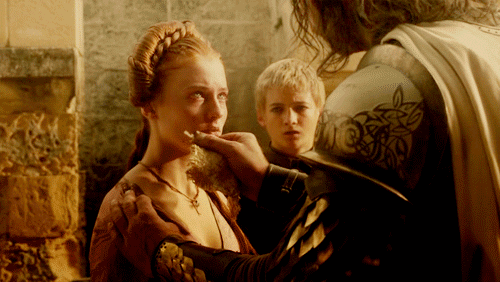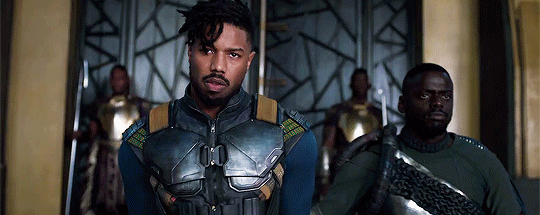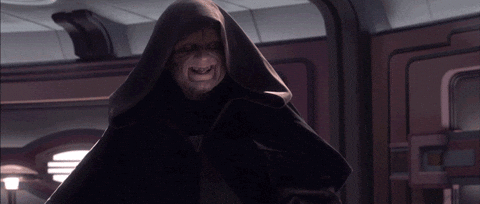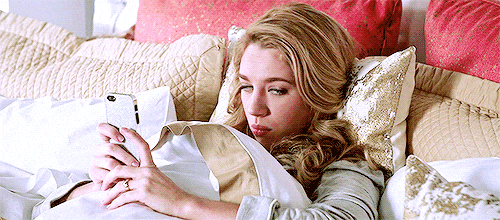Much of the talk about tropes revolves around the tired ones, around bad use of them and the clichés that come with them.
While it is true that writers can abuse tropes to the point where they become a crutch, tropes themselves aren’t inherently bad. Or good, for that matter. Tropes, as the article linked before states, are tools. A hammer can be used to fix a roof, or it can be used to bash someone’s head in. So too can Dysfunction Junction be masterfully used to portray a deeply dysfunctional group of people or make the drama seem forced and overpacked.
Even tropes that carry deeply negative connotations can be used for the positive. To subvert a trope you need to call upon it. Take Bury Your Gays. [WYNONNA EARP S1 SPOILERS] When Nicole Haught, out lesbian, was shot in the finale of Wynonna Earp‘s first season, there was a hot second in which everyone held their breath, thinking “no they didn’t!”. And they hadn’t. It was soon revealed that Nicole was wearing a bulletproof vest. [END OF SPOILERS] That moment of panic was caused by a direct reference to Bury Your Gays, with all the cues that come with the territory, and it gave the relief that followed a little more power. It made it feel like some ethereal evil was beaten.
Using tropes is about managing expectations. The world has had hundreds of years of storytelling to install these conventions and quick references so that when we see a person walking alone through a corridor with ominous music playing, we know something’s going to jump on that character any moment. Or at least we expect it. The writer then must be smart in either giving us what we expect or denying it to us. Tropes are short-hands that help us avoid a lot of chatter and explanation, especially on screen, where time is so precious. We should cherish them as much as we are weary of them, especially those who write.
So, to celebrate tropes, or rather good trope usage, I’ve compiled a list of ten tropes that I enjoy in stories, and that, when used wisely, just work.
Save the Cat
This term can apply to whole movie plots and was coined by author Blake Snyder in his book Save the Cat: The Last Book on Screenwriting You’ll Ever Need. While I would argue strongly against that bold statement, it is a very helpful book and it provides us with the gem that is the “Save the Cat” moment. A moment where a character does or says something that endears or redeems them to us. Like a big broody hero choosing to save a cat during a big explosion or chase scene.
This works especially well with characters who are prickly or are eventually going to transition from villain to hero. Like Zuko’s relationship with his beloved goofy uncle in Avatar: The Last Airbender, which eventually allows him to form a bond with the group of heroes. Another example would be the Hound’s soft spot for Sansa Stark in A Song of Ice and Fire series. Even though he’s incredibly creepy about it, you can tell this violent man somehow wants to protect the “silly little girl”.

The “Save the Cat” moment helps us connect with a character’s humanity and at least be open to rooting for them in the future. And judging by the fanbase of both Zuko and the Hound, I’d say it works.
Large Ham
A Large Ham is a larger than life character who is prone to be over dramatic, give grand speeches and just be, as the kids would say, generally Extra.
I love a well-done Large Ham (pun intended) because they are fun and explosive and a joy to see on screen. It might be good to note that a good Large Ham requires an actor willing to give it their all. My favorite example of an exceptional Large Ham is the Doctor, from Doctor Who. I have only fully watched the seasons since the show’s comeback in 2005, but I’ve dabbled in some episodes from the previous seasons and it would seem to me that every single Doctor has been a magnificent Large Ham.
I might get slammed for this, but my Doctor is Matt Smith. He was the Doctor when I started watching and I did love his Ham ways. He can be an especially large Ham when he gets upset, turning up the drama to 2000. Such is the case in the second episode of season 5 (his first) when he decides he must kill a space whale because he can’t bear the humans to be stranded or be eaten by it, and he’s all “no one human talk to me I’m mad”.
Because of the time-traveling nature of the show, it gives us the gift of Ham-to-Ham (link) combat—in which two or more Large Hams butt heads—with Doctor against Doctor. Matt Smith and David Tennant are both such outstanding Large Hams! Meanwhile, Jodie Whitaker is giving everyone a run for their money now with the sheer joy she exudes as the Doctor. I hope she stays for a long time.

Not So Different
Two characters on opposing sides of the conflict have the opportunity to see that they are not so different after all. This trope goes a long way in showing the nature of war and is used in several movies that explore this theme. Like the German soldier who opts to help Adrien Brody’s character in The Pianist for instance.
The 100 had excellent use of this trope in its first couple of seasons, showcasing what made the show great back then. The most notable example would be Lincoln and Octavia, [SPOILERS AHEAD] who ended up becoming an item for the first few years of the show. My favorite example was Clarke and Anya, who first met in peace negotiations to which they both brought snipers. Anya was the first to point out to Clarke and the Sky People that while their perspective was limited to protecting themselves, they had inadvertently caused damage to the grounder culture. The first and especially the second season of The 100 was a big Not So Different in general between the Sky People and The Grounders. It’s what made me like the show, and its loss, the reason I stopped (among other, more specific losses) [END OF SPOILERS]
Anti-Villain
An Anti-Villain is the opposite of an Anti-Hero. An embodiment of “the ends don’t justify the means”, the Anti-Villain usually has a noble cause, but chooses immoral or extreme methods to their end. They’re right but they’re going about it in absolutely the wrong way. An effective Anti-Villain is a tragedy in and of themselves, because they’re right to be angry, you see their point, and you can sometimes even see exactly where they went wrong.
Magneto from the X-Men franchise is a classic example of this. He suffered the Holocaust and the ostracization of being a mutant, both grossly unfair (is an understatement) and he chooses a path of violence and vengeance. He has lost faith in humanity and you get it. It’s why his discourse is so seductive to other mutants.
A more recent and fantastically executed example of an Anti-Villain is Killmonger in Black Panther. Boy, was he in the right in more ways than one. He and an entire section of the planet have been wronged for way too long. But his solution was to turn it around on his oppressors: “do to them what they did to us” because they could.

Killmonger is the single character from whom T’Challa, the protagonist and hero, learns most, the one who changed his entire perspective to ruling Wakanda.
Hope Spot
This is a tricky one, because when gone wrong it’s a disaster. TvTropes puts it best: “The Protagonist is about to face utter defeat. Suddenly, he finds a glimmer of hope, a reservoir for strength, a possible way out, a ray of light, a Forgotten Superweapon, what have you… only to be crushed cruelly by the bad guys returning in force.” When done right, it ups the stakes and, in a film,, generally leads to the “all is lost” moment, the protagonist or heroes’ darkest hour.
Usually the heroes (or the villains actually) will have come up with a plan, an unlikely to work last resource one. And it looks like it has, for a hot second there they feel the hope, and then it dies in their hands. It can be powerful, or it can be infuriating.
Without spoiling, I like how this was used in A Quiet Place and Mad Max: Fury Road. On TV The Flash does this a lot, particularly in season 3, or the Flashpoint season. Throughout that plotline, in which Savitar is the big bad, the heroes are constantly making desperate efforts to change the future in which they lose one of their team. Constantly it seems like they might have achieved it, only for Savitar to step in last second and prove them wrong. In my case, I quite enjoyed this season.
The Man Behind the Man
You thought this was the Big Bad, the heroes have been fighting them for so long, but you and the heroes were wrong. There is a puppet master who has been working from the shadows, sometimes a character we know and maybe even love. When masterfully handled, this is one of my favorite twists. It works great for upping the stakes, especially for a TV Show, where it can give you a whole other season of conflict and drama. It can help us understating a Villain or an Anti-Villain, and it gives clarity about the war being fought.
In Star Wars, the reveal of Emperor Palpatine as the true leader of the Empire was more of a shock for learning Darth Vader was being controlled—to a certain degree—all along. It gives Luke a fighting chance in convincing his father to turn his back on the Empire, which would have been impossible if Vader was The Empire.

A Song of Ice and Fire does this a lot and very well. [SPOILERS AHEAD] Tywin Lannister is the man behind a lot of what happens in King’s Landing. Varys is a notable Man Behind a Man, as well as Littlefinger, who effectively lit the spark that started the entire plot of the series—having Jon Arryn killed. There are still many to be revealed, I’m sure, and I have faith they will be as satisfying as the previous ones. [END OF SPOILERS].
I especially love Man Behind the Man when it has been there in front of us all long, and looking back, one can see the clues staring us right in the face.
It’s Personal
I’ve written before about how storytelling is kind of very personal once we get truly engaged with the characters and their world. When we are committed to the good outcome of a fictional character, what’s personal for them is personal for us, too. When the heroes are fighting the big bad, it usually starts out as an ideological fight. Batman wants to protect Gotham so he fights the Joker. Diana wants to defeat Ares because it’s what’s right.
But when it hits closer to home is when the fight gets personal. [SPOILERS AHEAD] The Joker kills Rachel: Now it’s personal. Ares is Diana’s brother; he decimated the Gods and it’s his fault Steve has died: Now it’s personal. The Flash milks this to no end with the first season (and probably the best) Big Bad, Edward Thawne. The death of Barry Allen’s mother is the defining event of his entire persona and life. He lost both his parents for it, and it informs nearly every decision he’s made. So, Thawne is a demon that constantly haunts him, even after he’s technically died. [END OF SPOILERS]

Locked in a Room
This is very closely related to Not So Different, but it necessitates the situation that has two or more opposing forces who do not like each other get trapped in a small enclosed space for some reason. There is nothing to do but talk and maybe hash out their differences. I’m a big sucker for this one. It forces characters to talk and it does kind of force the writer to find their character’s voice. It’s a textbook writing prompt for when you’re stuck.
The tension of two people who have got a lot of baggage with each other and are maybe holding it in is bound to burst when Locked in a Room. Fear the Walking Dead recently did this with Alicia Clark, one of the original protagonists of the story, and Charlie, a recent addition to the show. [SPOILERS AHEAD] Alicia was trapped in a house during a thunderstorm with her brother’s murderer and a gun, stuck between protecting her (a child) and killing her. [END OF SPOILERS] It was a great hour of television, and it made me glad I’ve stuck with the show despite how bad it can get from time to time.
Cliffhanger
Everyone knows what a cliffhanger is at this point. For episodic storytelling like TV and comic books, cliffhangers are expected. They’re what keep people reading or watching. A compelling, well placed cliffhanger will keep you coming back for your book or to your TV set periodically, or binging an entire season of a show in a week. Or all seven seasons of a show in a month. It happened to the friend of a friend…
The season 5 finale of Grey’s Anatomy was a cliffhanger that had me reeling for months after. [SPOILERS AHEAD] In it, after finally recovering her memory from a surgery, Izzie suffers heart failure (also a Hope Spot) and as doctors scramble to resuscitate her, on the other side of the hospital Meredith discovers an John Doe who was run over by a bus is actually George O’Malley. In a sequence that pulls on some magical realism, Izzie and George find each other in the elevator. George is dressed up and ready, and he calls Izzie to come with him. And Izzie is so happy to see him, but then she hesitates… And on to season six! It was a long and well-executed sequence that back then, without the knowledge about who had quit the show, really had you questioning whether these two characters would leave us forever. [END OF SPOILERS] It is of note that the best cliffhangers often make the writers struggle on the comeback, because it’s hard to live up to that well-placed question.
Cliffhangers are such a norm in storytelling that one might think it’s impossible to screw up this trope, but it can be done. Sometimes the purpose of it is so glaringly obvious and clichéd on top of that, that the “open question” is ineffective. On the flip side, sometimes one simply doesn’t want to care about the answer to the question. The season four finale of Jane the Virgin leaves two cliffhangers, one regarding Petra and new girlfriend Jane Ramos, and the other regarding Jane Villanueva. The former has me anxiously anticipating the fifth season, the latter still makes me cranky when I think about it.

Never underestimate a good cliffhanger!
Shut Up, Hannibal!
I’d like to end this list with a trope that very nearly always works. Shut Up, Hannibal is essentially when the hero interrupts the villain’s monologuing because they simply do not have time for that spiel. I don’t care what you have to say, I came to end you once and for all! Let’s get down to business! Also, I won’t be dumb enough to give you this chance to trick me and get away.
Hulk’s merciless pounding of Loki in the first Avengers is a very popular example. I personally love Hercules bashing in Ares’s head in Disney’s Hercules. It’s just a great, fun little moment that I’ve never seen fail.

If you thought of a great (or terrible) moment with one or all these tropes, please let me know! Have wonderful Holidays to those who celebrate them, and a smashing end of December to those who don’t and those who do.

